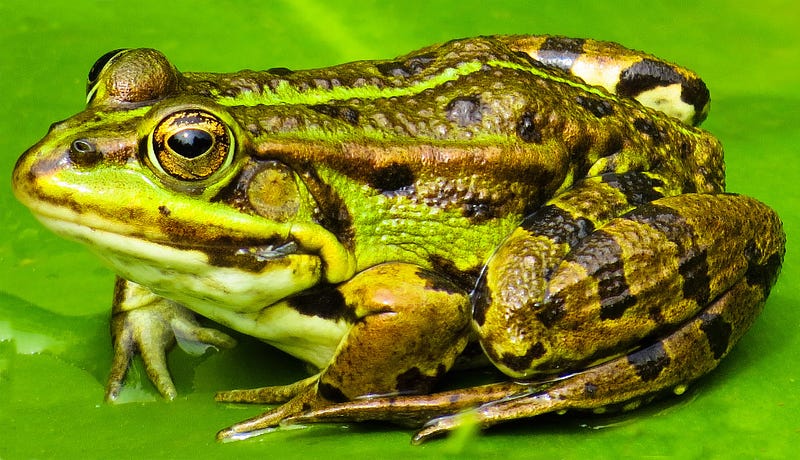Exploring the Fascinating World of Amphibians and Their Traits
Written on
Chapter 1: Understanding Amphibians
Amphibians represent one of the most diverse groups of animals on the planet, with approximately 6,500 species spread across almost every continent. These incredible creatures possess unique characteristics that have allowed them to thrive for millions of years. Below, I will outline the features that make amphibians so remarkable.

[Photo: David Mark from Pixabay]
Despite their seemingly primitive appearance, amphibians have evolved numerous traits that enhance their survival. They existed long before dinosaurs roamed the Earth, and new species are still being uncovered, underscoring the adaptability of these animals to their environments.
What Exactly Are Amphibians?
When discussing amphibians, it's essential to recognize their classification as ectothermic vertebrates. They are uniquely adapted to live in both aquatic and terrestrial habitats. While most species dwell on land, some can be found in freshwater environments, tree branches, and on the ground. They inhabit nearly all continents, with Antarctica being the only exception. Hot and temperate climates are particularly favorable, with the highest diversity found in South Asia, Southeast Asia, and Africa, while North Asia and Europe host the fewest species.
Types of Amphibians
Currently, amphibians are classified into a single subclass known as Lissamphibia, which is further divided into three orders:
- Anuran amphibians (Anura): frogs and toads
- Tailed amphibians (Caudata): newts and salamanders
- Legless amphibians (Gymnophiona)
The total number of recognized amphibian species is about 6,500, though some estimates suggest there may be as many as 8,500. This discrepancy arises from frequent discoveries of new species in tropical regions, while many others face extinction due to environmental degradation.

[Photo: Susanne Jutzeler, Schweiz ?? ?Thanks for Likes from Pixabay]
Characteristics of Amphibians
The traits of amphibians have ensured their significant presence in the vertebrate world. While birds and mammals are also highly adapted to their environments, amphibians exhibit a remarkable diversity that is often surprising given their small size and vulnerability.
Unlike marine creatures like the blue whale, which can grow to 33 meters, the largest amphibian, the Chinese giant salamander, reaches about 180 cm. However, most amphibians are much smaller, typically measuring only a few centimeters to several tens of centimeters.
Amphibians possess moist, thin skin, essential for gas exchange despite being a weakness against predators. Although most adults breathe through lungs, their skin plays a critical role in respiration. Some species have developed effective defense mechanisms, with toxic secretions from specialized glands.
Although amphibians lack claws and have relatively short teeth, they are not defenseless. They have keen senses of smell and hearing, along with good eyesight (with some exceptions). A few species even possess a lateral line system, allowing them to detect electrical signals.
Another defining trait of amphibians is their poikilothermic nature, meaning their body temperature fluctuates with their environment. While many are primarily terrestrial, their adaptations allow for partial aquatic living.

[Photo: Sonja Rieck from Pixabay]
Feeding Habits of Amphibians
Adult amphibians are predominantly carnivorous and prefer live prey. They hunt moving objects, primarily consuming insects, earthworms, spiders, and small crustaceans. Larger amphibians may also eat reptiles, other amphibians, small mammals, and even bird nestlings, with instances of cannibalism reported among certain species.
Reproductive Strategies
Amphibians lack copulatory organs, and in most cases, fertilization occurs externally in water. The female lays eggs enveloped in a jelly-like substance, while the male releases sperm over them. The eggs develop into tadpoles, which are aquatic, herbivorous, and resemble fish. These tadpoles undergo metamorphosis to become adult amphibians.
Anatomy of Amphibians
In anuran amphibians, the body is divided into distinct head and thorax regions, while tails are present only in caudal species, excluding the larvae of anurans. A notable feature is the differing number of toes on their front (four) and back (five) limbs, which affects their movement, giving them a slow and clumsy appearance. However, most species can escape quickly when threatened.

[Photo: Gerhard from Pixabay]
Distinguishing Amphibians from Reptiles
While amphibians and reptiles share some characteristics, they can be differentiated primarily by skin texture. Reptiles have dry skin often covered in scales, while amphibians have moist and smooth skin, with only a few legless species possessing sparse scales.
Additionally, amphibians typically have webbed feet without claws, unlike reptiles. Sound is another distinguishing factor; amphibians are vocal, producing a variety of sounds, whereas reptiles, excluding snakes, are generally silent.
The first video titled "Respiratory Organs In Amphibians" explores the various adaptations amphibians have developed for respiration and how their skin plays a crucial role in this process.
The second video, "Did You Know: Salamanders Breathe Through Their Skin?" delves into the fascinating respiratory adaptations of salamanders, highlighting their unique ability to absorb oxygen through their skin.
In conclusion, amphibians are incredible creatures with unique adaptations that allow them to thrive in diverse environments. Their evolutionary history and resilience make them a subject of great interest in the study of biodiversity.
Thank you for reading! If you enjoyed this article, feel free to show your appreciation with claps or consider following me for more insights. Your support is greatly valued!